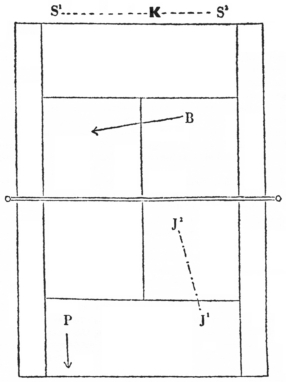
|
Excerpts fromGamesmanshipStephen Potter |
INTRODUCTORY
What is gamesmanship? Most difficult of questions to answer briefly.‘The Art of Winning Games Without Actually Cheating’ – that is my personal ‘working definition.’ What is its object? There have been five hundred books written on the subject of games. Five hundred books on play and the tactics of play. Not one on the art of winning.
I well remember the gritty floor and the damp roller-towels of the changing-room where the idea of writing this book came to me. Yet my approach to the thing had been gradual.
There had been much that had puzzled me – I am speaking now of 1928 – in the tension of our games of ping-pong at the Meynells.’ Before that there had been the ardours and endurances of friendly lawn tennis at the Farjeons’ house near Forest Hill, where Farjeon had wrought such havoc among so many visitors, by his careful construction of a ‘home court,’ by the use he made of the net with the unilateral sag, or with a back line at the hawthorn end so nearly, yet not exactly, six inches wider than the back line at the sticky end. There had been a great deal of hard thinking on both sides during the wavering tide of battle, ending slightly in my favour, of the prolonged series of golf games between E. Lansbury and myself.
June 8th 1931
But it was in that changing-room after a certain game of lawn tennis in 1931 that the curtain was lifted, and I began to see. In those days I used to play lawn tennis for a small but progressive London College – Birkbeck, where I lectured. It happened that my partner at that time was C. Joad, the celebrated gamesman, who in his own sphere is known as metaphysician and educationist. Our opponents were usually young men from the larger colleges, competing against us not only with the advantage of age but also with a decisive advantage in style. They would throw the service ball very high in the modern manner: the back-hands, instead of being played from the navel, were played, in fact, on the back-hand, weight on right foot, in the exaggerated copy-book style of the time – a method of play which tends to reduce all games, as I believe, to a barrack-square drill by numbers; but, nevertheless, of acknowledged effectiveness.
In one match we found ourselves opposite a couple of particularly tall and athletic young men of this type from University College. We will call them Smith and Brown. The knock-up showed that, so far as play was concerned, Joad and I, playing for Birkbeck, had no chance. UC won the toss. It was Smith’s service, and he cracked down a cannonball to Joad which moved so fast that Joad, while making some effort to suggest by his attitude that he had thought the ball was going to be a fault, nevertheless was unable to get near with his racket, which he did not even attempt to move. Score: fifteen-love. Service to me. I had had time to gauge the speed of this serve, and the next one did, in fact, graze the edge of my racket-frame. Thirty-love. Now Smith was serving again to Joad – who this time, as the ball came straight towards him, was able, by grasping the racket firmly with both hands, to receive the ball on the strings, whereupon the ball shot back to the other side and volleyed into the stop-netting near the ground behind Brown’s feet.
Now here comes the moment on which not only this match, but so much of the future of British sport was to turn. Score: forty-love. Smith at S1 (see figure) is about to cross over to serve to me (at P). When Smith gets to a point (K) not less than one foot and not more than two feet beyond the centre of the court (I know now what I only felt then – that timing is everything in this gambit), Joad (standing at J2) called across the net, in an even tone:
‘Kindly say clearly, please, whether the ball was in or out.’

Key: P = Potter, J = Joad, S = Smith, B = Brown. The dotted line represents Smith’s path from S1 to S2. K represents the point he has reached on the cross-over when Joad has moved along the line (dot and dash) J1 (where he had tried to return Smith’s service) to J2. Smith having arrived at, but not further than, the point K on the line S1–S2, J (Joad) speaks.
Crude to our ears, perhaps. A Stone-Age implement. But beautifully accurate gamesmanship for 1931. For the student must realize that these two young men were both in the highest degree charming, well-mannered young men, perfect in their sportsmanship and behaviour. Smith (at point K) stopped dead.
SMITH: I’m so sorry – I thought it was out. (The ball had hit the back netting twelve feet behind him before touching the ground.) But what did you think, Brown?
BROWN: I thought it was out – but do let’s have it again.
JOAD: No, I don’t want to have it again. I only want you to say clearly, if you will, whether the ball is in or out.
There is nothing more putting off to young university players than a slight suggestion that their etiquette or sportsmanship is in question. How well we know this fact, yet how often we forget to make use of it. Smith sent a double fault to me, and another double fault to Joad. He did not get in another ace service till halfway through the third set of a match which incidentally we won.
That night I thought hard and long. Could not this simple gambit of Joad’s be extended to include other aspects of the game – to include all games? For me, it was the birth of gamesmanship.
Stephen Potter, Gamesmanship, 1947.